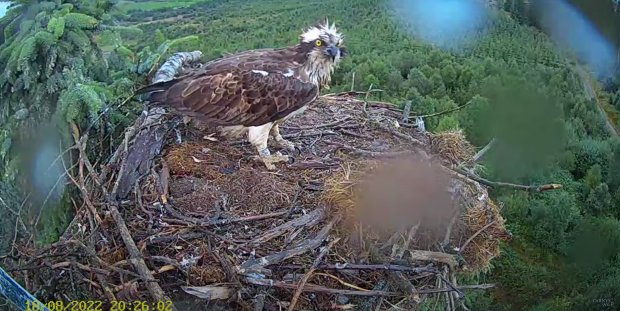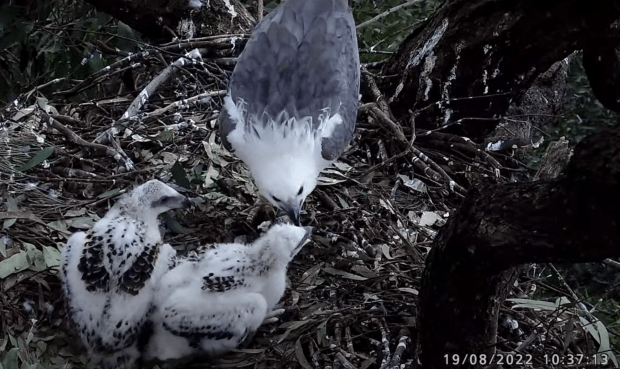7 April 2024
Hello Everyone,
It was a sad day in the garden on Saturday morning.
Everyone always talks about a Spark Bird. There can be several of these significant birds throughout our lives. As a child in Oklahoma, it was the Blue Jays and Cardinals that my dad fed out of his hand. As a teenager, it was the Red-tail Hawks. Then, decades later, there was the most magical moment. It changed my life. It was a winter morning in the garden when my eyes connected with those of a female Sharp-shinned Hawk within half a metre of me. Since that day, hawks have been visiting the garden in search of a “Sparrow Blue Plate Special”. Now, to have an Immature Cooper’s hawk die in my garden is simply heartbreaking. The carcass is going for testing for HPAI, as there were no obvious signs of trauma. However, I suspect the hawk flew into the garage belonging to the house next door or somehow broke its neck, colliding with the thicker branches trying to catch a songbird.
The happy ending to this, if there could be one, is that the hawk’s body is going to our local museum as part of their specimen collection. If you find a bird whose carcass is in good condition, check with your local natural history museum or wildlife centre to see if they would be interested in having it as part of their specimen collection.
It was 14 degrees C Saturday afternoon at the nature centre. The Canada Geese had moved from the main lake to the smaller ponds and fields to forage. There were hundreds of Dark-eyed Juncos, several dozen Chickadees, Woodpeckers, and House Sparrows enjoying the warmth as a huge hawk flew overhead.




Meadow is at the Audubon Centre for Birds of Prey and is getting the first-class care this rehabilitation centre is known for!

Meadow being weighed.

An ambassador celebration at Audubon!

Two little eaglets being fed at the ND-LEEF nest. Looks like the new Mum has been named Gigi.

There has been some concern for the One eaglet in the nest at Tremplealeau, Wisconsin. The male disappeared and the female is alone.


UPDATE: Dad has returned to the Trempealeau Nest and two fish have come in already – Saturday! Yeah.

The situation at Moorings Park improves for Tuffie bite by bite.

Tuffie had some of the leftover fish early and it appeared that he might have had some other bites. It was when I returned from my walk at the nature centre, that Tuffie had a nice feeding. After Ruffy ate, Tuffie was fed and then both of them ate together.
‘H’ gives us a more detailed day’s report for our little one at Moorings Park. “Tuffy ate at least 54 bites at the first meal of the day; 1109 headless fish, Tuffy was attacked by Ruffie, Tuffy moved away to the rail and never went back to eat. Harry removed the leftover fish;1156 Harry returns with what appeared to be the leftover fish. Tuffy is beaked several times and was not able to eat;1455 Harry in with whole tilapia, Tuffy is beaked and intimidated several times while Ruffie is fed. At 1526 Ruffie moves away, and Tuffy is finally able to eat. At 1533 Ruffie returned to the table, Tuffy was intimidated and turned away. Ruffie ate until 1538, then Tuffy moved up and the two ate side by side until 1540, when Tuffy was beaked again. Ruffie finished the fish. Tuffy ate at least 66 bites at this meal.”
With my bad math, that would seem to be at least 120 bites of fish for Tuffie today – more than the two previous days counts.




Oh, the size difference between these two! So glad that third egg didn’t hatch.

Last instalment from ‘H’ – what a good day for Tuffie all things considered. “1710 large headless fish – Tuffy got 3 quick bites, was intimidated and turned away, later got 3 more bites and was beaked. Ruffie ate until 1722 then moved away. Tuffy had a short private feeding until 1726, then was beaked by Ruffie. Ruffie ate some more, then Tuffy got a few more bites starting at 1730. Ruffie quit the feeding again at 1736. Tuffy voluntarily moved away from Mom from 1738 t o 1740. Tuffy ate a few more bites at 1740, and then Tuffy went and laid down at 1742. Total bites for Tuffy at this meal = at least 77 bites.Total bites to Tuffy for the day so far = 197”.
The crop is almost as big as Tuffie!!!!!!! Get the tissue box.


The little bottom sticking out from under Sally belongs to Tuffie who, all in all, had a reasonable day. Each day is getting better in terms of food intake for Tuffie.
Over the past seven years, turning points come on nests like this one. Whether or not it is the change from the Reptilian Phase into the period when juvenile plumage is coming, or if the weather shifts and the fishing gets better, or if the female ‘decides’ that the little one is going to live and begins to feed it, we should be watching and waiting to see what it is on this nest.
Many of you will have shed tears of joy for little Tuffie today. He is hanging in there and all that good energy from the Tuffie Fan Club must be helping!

The second egg was laid at the Patchogue Osprey platform on Long Island Saturday morning around 0858.

Storm Kathleen is hitting the UK hard.
In the UK, Storm Kathleen is hitting areas hard. Dorcha was just blown off the perch at Loch Arkaig.
The storm is not blowing so hard at Loch of the Lowes, yet.

The winds were howling at Alyth, where Harry and Flora have their nest.


Storm Kathleen is kicking up waves at Rutland as Maya and Blue try to protect their eggs.


Idris holding on to a huge fish while the gale blows at Dyfi.

Telyn is soaked.

What a great screen capture of Idris and Telyn.

Extremely gusty at Glaslyn.

Same gusts at Llyn Brenig where there was a fish delivery. You might recall Blue 372. She was over at Glaslyn with Aran and flitting from nest to nest. She is trying to find a mate…well, this is her! And this is what is happening in the image below: “LJ2 has been joined on the nest by Blue 372 this afternoon.Blue 372 is a 3 year old Scottish female translocated to Poole Harbour in 2021, she has been seen on a number of Welsh nests over the past week or so and is now braving the winds up at Llyn Brenig. LM6 our regular female has not yet returned from migration.”
She is determined. Will this be her nest?

‘H’ reports that the Mum at Carthage laid the season’s first egg. Saturday the 6th of April at 10:17:10.

Confirmed pip at US Steel’s nest of Claire and Irwin – and now it is a hatch. looks like another crushed egg hatch. Little one alive and squiggling this time!


Darling Big Red never seems to age except for her feet and legs. She and Arthur continue their dedicated teamwork to hatch those four little hawklets.



Iris might have wished she had waited a few days to return to Montana.



Do not get upset if you check on the little owlet at Wolf Bay. They are both fine. There is a prey item currently on the nest, Saturday evening, that is white.

JBS20 is getting those wings strong. Adult in to fed but JBS20 is good at self-feeding!




Was it a quail lunch at the Redding Eagle nest? or a Guinea Fowl? Both eaglets are doing very well.



E23 gets a fish delivery from Mum. It must have been delicious. The fledgling ate all of it.
A family portrait at the West End nest of Akecheta and Thunder.

Little heads pop up for dinner at the Fraser Point nest of Cruz and Andor.

All is well at Denton Homes.

Happy eaglets at Decorah North.


Diana Persinger recorded a video for FB of a very messy meal for these two at Decorah North.

Everything is good at Little Miami.

Little fluff balls at the ND-LEEF nest.

Worried about Angel? She was on the nest with Tom on Friday.
There are no worries about Leaper and Jersey. They had crops most of Saturday and were about to burst late in the day and Dad had a fish in his talons and Mum had one, too!
The fortune of a nest can shift from good to bad to good. Let us hope this is what is happening at Moorings Park.

Hatch watch has begun for the Fort St Vrain Eagles in Colorado.

There is some thought that the ‘original’ Dad at Pittsburgh-Hayes has returned to the nest after being gone for a very long time. (I would have to check my Memorial Page). Is it possible he was in care, rehabilitated, and released and came home?
This was posted by WingsOfWhimsy with the photos below. They sure look alike.
“WingsOfWhimsy 20 hours agoA little bit of interesting news to share. I will say right up front that I have VERY little personal knowledge to go on here, so I will direct you to either the live cam: https://www.youtube.com/watch?v=l95k-… or the Facebook Group: https://www.facebook.com/groups/36054… for additional info. There is a theory that the original “Dad” from the Pittsburgh Hays nest has returned. Dad has been away for quite some time, and HM2 has bonded with Mom, although their egg failed to hatch this season. (I believe mom was first seen with HM2 in September.) Recently a visitor has been on the scene, and I have to admit… even I see the similarities! Could it be that Dad has returned? This is certainly exciting, but also a bit concerning. If this is Dad, both he & HM2 likely consider Mom and the nest to be theirs. These comparison photos were shared by a FB Group user: Lynda Philips, comparing Dad and the recent visitor. This is all I know right now, but I will update as best as I can. The folks in the group or on chat are surely more familiar than I am, though. Please consider checking in with them for more details!”


Yesterday I included a video by DaniConnorWild to show you the penguins in Antarctica. Today, here is a sobering article on the unprecedented heat rise on that continent and the fears that it has for the penguins and for humans. The author says with the rise to 38.5 C, “These events have raised fears that the Antarctic, once thought to be too cold to experience the early impacts of global warming, is now succumbing dramatically and rapidly to the swelling levels of greenhouse gases that humans continue to pump into the atmosphere.”
Killing Owls to save Owls. Is it really the answer?
Thank you so much to the following who sent me comments, news, their pictures, screen captures, videos, articles, and those who operate the streaming cams that helped me to write my post this morning: ‘Geemeff, H, J’, Audubon Centre for Birds of Prey, Stephen Basly, Tremplealeau, Moorings Park, PSEG, The Guardian, Geemeff, The Scottish Wildlife Trust (LOTL), Alyth SS, LRWT, Dyfi Osprey Project, Marissa Winkle, Bywyd Gwylld Glaslyn, Llyn Brenig, DTC, PIX Cams, Cornell RTH Cam, Montana Osprey Project, Wolf Bay, JB Sands Wetlands, FORE, IWS/Explore, Denton Homes, Raptor Resource Project, Diana Persinger, Little Miami Conservancy, Window to Wildlife, Duke Farms, and Sassa Bird.


























































































































































































































































